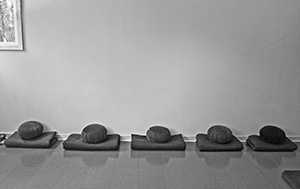What Happens in a Zazen Session?
While the basic form of zazen practice is consistent throughout the Soto Zen tradition, each temple or dojo tends to have its own way of doing things, hence the details of practice vary from place to place. Tony teaches a form of zazen practice transmitted to him by Livingston-Roshi. Taisen Deshimaru created this form as a modification and simplification of a traditional Japanese Soto way of conducting a Zen practice period. For more, see About Zazen.
 Each of our formal Zen dojos (also known as a zendo) is a simple room set up exclusively for Zen practice. An altar is situated at the far end of the room, with enough room behind it for a person to pass. A statue of a Buddha is given the central position on the altar. The altar also holds an incense bowl, potted plants and/or flowers, candles and the kyosaku (stick of awakening). Each practitioner sits on a round cushion called a zafu in a straight line along each of the side walls, facing the wall. The teacher (or godo) sits at the front of the dojo, just to the right of the entrance facing out, toward the altar.
Each of our formal Zen dojos (also known as a zendo) is a simple room set up exclusively for Zen practice. An altar is situated at the far end of the room, with enough room behind it for a person to pass. A statue of a Buddha is given the central position on the altar. The altar also holds an incense bowl, potted plants and/or flowers, candles and the kyosaku (stick of awakening). Each practitioner sits on a round cushion called a zafu in a straight line along each of the side walls, facing the wall. The teacher (or godo) sits at the front of the dojo, just to the right of the entrance facing out, toward the altar.
Our practice is formal in the sense that we adhere to the ritual form of ceremony described below and the fact that the teacher and ordained students wear traditional robes and the kesa or rakusu while sitting. We also observe certain simple ritual formalities while in the dojo—for example, bowing when entering and leaving—thus conveying a sense of respect for our practice, our tradition, the place we practice, and all those who practice with us. All of these formalities are shown to a beginning student in an orientation session prior to their first zazen period.
Practitioners arrive at the dojo five or ten minutes before a zazen period so they will have enough time to get settled before the period begins. Latecomers should not enter the dojo but may sit in the reception area outside. The teacher enters last and offers incense, then sits and rings a small gong three times, indicating the formal beginning of the zazen period. A zazen period usually lasts 30 minutes for daily practice and 40 minutes for a sesshin. At the end of the first zazen period, the bell is struck twice, indicating the beginning of walking practice, kinhin, which is a very slow walk around the dojo, with one's footsteps being coordinated with the breath. At the end of kinhin, the gong is struck, everyone returns to their place, and the second zazen period begins. The end of the final zazen period is indicated by one strike of the gong. Zazen is usually silent, but sometimes Tony will give a kusen, verbal teaching, during a period.
Following zazen there is a short ceremony. A traditional sutra, the Hannya Shingyo (commonly known as the “Heart Sutra”), is chanted, with accompaniment by a small wooden drum, the mokugyo, and the gong. Then the Four Great Vows of the Bodhisattva and Universal Dedication are chanted. All chanting is done in Japanese and chant cards are available. The ceremony ends with everyone doing sampai, a series of three prostrations indicating deep respect, and mutual bows between teacher and students.
Following zazen, practitioners frequently meet informally to chat, and from time to time the Sangha gets together for lunch, a potluck, or other social events.
